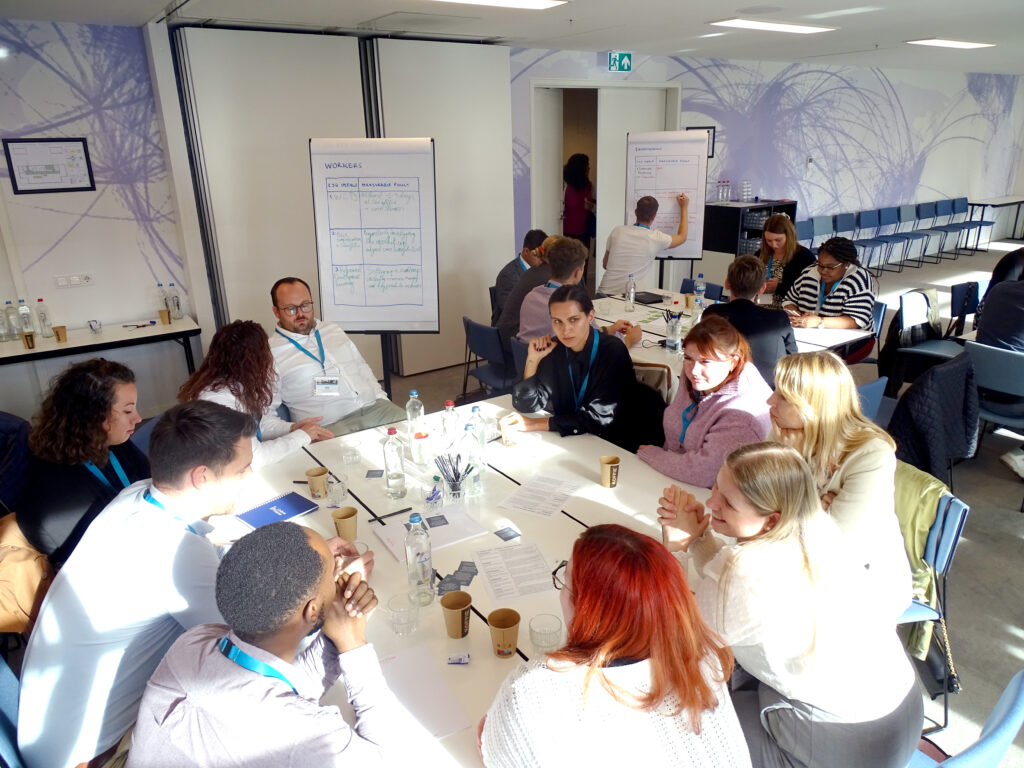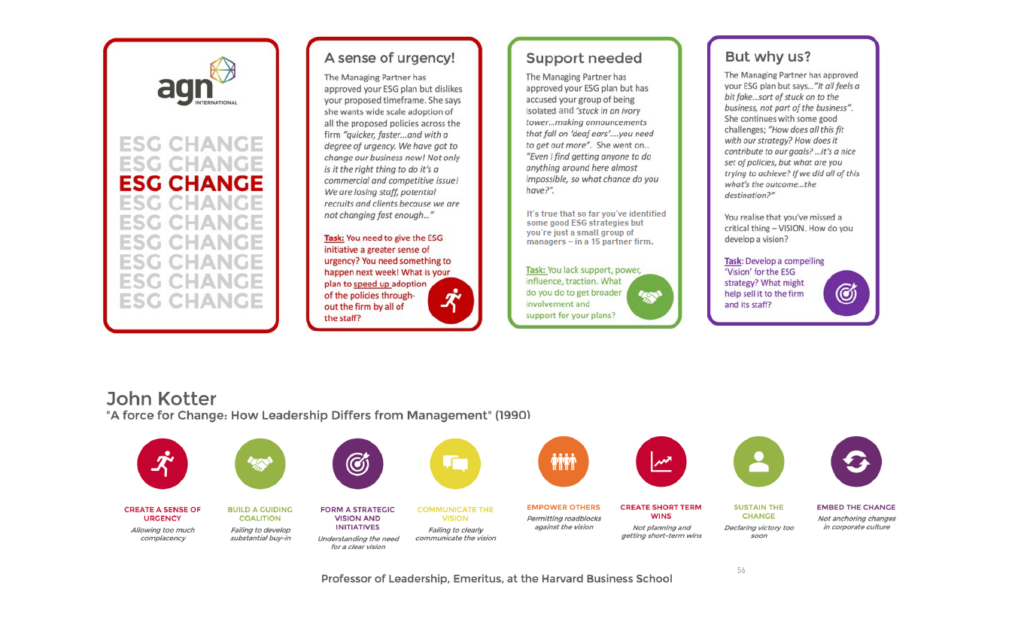AGN Global Business Voice: Practice Management
How might an ESG (Environment, Social and Governance) strategy enhance your staff engagement levels and help drive talent retention and recruitment? We detail a staff workshop methodology that any member can use to engage staff in developing internal ESG Policy.
ESG Strategy Introduction
Environmental, Social, and Governance (ESG) policy frameworks and standards are used by organisations to align their business model with the values of the partners, and in some cases to adhere to regulation, but also leverage the commercial, environmental and social opportunities such commitments might
deliver.

As trailed in ESG Part 1, AGN believes there is a valuable opportunity for firms to adopt a visible and distinctive position on ESG issues and drive immediate competitive differentiation and commercial benefits. A credible ESG strategy can turbocharge your firm’s appeal when:
Talent Recruitment
Recruiting younger talent who
tend to be more attuned to ESG
concerns. Meaningful work and social
responsibility are important factors
for Gen Y and Z in choosing a place to
work.
Talent Retention
Motivating and engaging with existing
talented team members who want
to have pride and confidence doing
meaningful work for an employer
who is making a visible social and
environmental contribution.
Work from Suppliers
Securing work from suppliers who are
required to perform to certain ESG
standards, and/or whose vendor supply
chains are increasingly under scrutiny
for their environmental impact.
Reputation and Brand Value
Building market reputation and brand
value – Commitment and responsibility
in ESG will grow the reputation of your
firm and could attract new clients as
well as increase the loyalty of existing
key customers.
In ESG Part I we used the well established ‘B Corp’ accreditation methodology to help structure our approach. But B-Corp is only one of the ESG accreditation bodies that could ‘certify’ your ESG strategy – there are others;

ESG Accreditation Bodies
A range of ESG accreditation bodies are available:
| B Corp Certification: B Corp certification is one of the most well-known ESG accreditation frameworks. B Corps are for-profit companies that meet high social and environmental performance standards. The certification is provided by B Lab and evaluates a company’s impact on its workers, customers, community, and environment. |
| Global Reporting Initiative (GRI): GRI provides guidelines for organisations to report on their economic, environmental, and social performance. GRI’s standards are used by many companies globally to disclose ESG information in their annual reports. |
| United Nations Global Compact (UNGC): The UNGC is a voluntary initiative for businesses to align their operations and strategies with ten universal principles in areas such as human rights, labour, environment, and anti-corruption. Organisations that join the UNGC commit to reporting on their progress toward these principles. |
| Sustainability Accounting Standards Board (SASB): SASB focuses on industry-specific ESG reporting standards. It provides guidelines for companies to disclose financially material sustainability information tailored to their industry. |
| Task Force on Climate-related Financial Disclosures (TCFD): The TCFD provides recommendations for disclosing climate-related financial information. It encourages organisations to report on the risks and opportunities associated with climate change in their financial filings. |
Competing ESG accreditation frameworks or standards may include sector-specific initiatives, regional standards, and various industryspecific ESG benchmarks. Some examples of these include:
| Carbon Disclosure Project (CDP): CDP is focused on measuring and disclosing environmental data, particularly carbon emissions and water usage. It is widely used by companies for climate-related reporting. |
| Dow Jones Sustainability Indices (DJSI): The DJSI evaluates the sustainability performance of leading global companies across various industries. It assesses ESG factors and recognizes companies that perform well in sustainability. |
| ISO 14001 and ISO 26000: These are international standards for environmental management and social responsibility, respectively. While not ESG accreditation frameworks per se, they provide guidelines and certification for organisations aiming to improve their environmental and social practices. |
| Equator Principles: These principles provide a framework for financial institutions to assess and manage environmental and social risk in project financing. They are often used by banks to assess the sustainability of projects they finance. |
It’s important to note that the ESG landscape is continually evolving, and new frameworks and standards may emerge over time. Additionally, companies may choose to adopt multiple frameworks to address various aspects of ESG performance and disclosure. The choice of framework often depends on your firm’s goals and aspirations – and to some extent on which accreditation body is likely to remain as a brand for the long term.

But there is another way…
If you are not convinced about the accreditation approach, it doesn’t seem to represent value for money, you can’t decide which one is likely to remain standing in some future shake-out of brands, or such a thing is simply overkill for your firm, then you could consider an alternative self-help approach.
The connection between ESG and Employer Branding
The most important brand in most people’s lives is not a consumer product or service, it’s the brand they work for – their employer brand. There are a range of things you can do to strengthen your employer brand’s appeal – making your firm more attractive to stay with either for existing employees but also to increase its appeal for potential employees.
An ESG policy can enhance an accounting firm’s employer brand in several ways.
Here is how:
- Signals Social Responsibility: Implementing an ESG policy signals to employees, and potential talent
that the firm wants to make a positive impact beyond financial results. - Reputation: A clear ESG policy can enhance the firm’s reputation among potential employees. It demonstrates that the firm is ethical, responsible, and forward-thinking.
- Differentiation: At least for a near term period the policy can help you stand out from competitors and serve as a unique selling point that attracts individuals.
- Sense of Purpose: An ESG policy can boost employee engagement by giving employees a sense of purpose in their work.
- Millenials and GenZ: Younger generations often prioritize working for organisations that align with their values and beliefs.
On the face of it this probably looks like a list of desirable qualities for any firm – and as with much associated with brand strategy can seem a little esoteric. However, the fact is that these employer brand facets are within reach through some hard work and commitment.
An ESG Strategy Staff Workshop
55 NextGenners, Rotterdam and an ESG Workshop Structure
At AGN’s Excellent Plus training event in Rotterdam in October 2023, we worked with a mixed group of 55 NextGenners, from member firms across EMEA to pilot a workshop methodology for creating a staff-led policy. The intention was to engage the group in road testing a prototype methodology that could then be rolled out to members as a useful ESG staff engagement tool.
The Workshop – outline approach
We pulled together an amalgam of headings and ESG categories drawn from a range of accreditation organisations such as B Corp, NetZero, GRI to create a model with 5 reconisable ESG Policy Categories that might apply to an accounting firm.
ESG Policy Categories:
- Organisational Governance
- Workforce Well-being
- Community Engagement
- Environmental Responsibility
- Customer Impact
Running this workshop with your staff, or key groups of staff could be a practicaland engaging way to boost your firms ESG efforts or launch an ESG policy development program.
ESG Workshop Outcomes:
- Engaged and motivated staff.
- A relatively detailed ESG policyframework that could be developed into a full strategy
- An understanding of what’simportant and motivating froma staff perspective.


Running The Workshop With Your Staff
Stage 1 – Setting up and briefing
- Appoint a facilitator – senior partner or ambitious NextGenner.
- Organise a meeting room adequate to arrange staff into cabaret style layout.
- Give a brief background presentation (provided in our ESG workshop pack) about ESG, what it means, and examples of ESG policies. The presentation explains why it is a critical business issue, the commercial opportunity it represents, and how it needs to apply to firmwide policy and behaviour.
- The workshop facilitator organises the group into table teams of mixed discipline individuals. Each table should represent a Policy Area such as Organisational Governance, Workforce Well-being etc.
A series of flipcharts should be made available for each table. The first three pages of the flipcharts have standard feedback charts that teams are required to complete and talk to. The workshop session including a tea break should take (3-4 hrs). (flipchart templates are provided in the AGN pack).
Introduce a competition element to the workshop with 1st place table winners individually receiving, for example, the latest Amazon top selling management book, and second placed table members receiving bars of chocolate!

Stage 2 – Teams to consider the Policy Priorities that apply to their Policy Category – prioritise top 5 most relevant
- Each table are given the relevant deck of 15 Policy Priority cards for their teams designated Policy Category and asked to discuss the relative merits of each and determine a top 5 priorities that they would apply to the firm and to consider why.
- The facilitator explains that they should complete the first flipchart sheet, and that they will be asked to present their conclusions and rationale for their approach. Each table has to agree and nominate a presenter. (20 mins)
- The facilitator asks each table to present their results and rationale in turn. Asking questions about their chosen priorities, prompting them to be specific about their choices and challenging them over what they may have left out.

AGN Note: This process of prioritisation encourages the teams to consider and discuss the firm’s priorities, and as they are required to prioritise, they are forced to debate what is best for the firm.
Stage 3 – Due to limited time and resources the teams need to narrow down the 5 ‘Policy Priorities’ to 3
The table teams are now challenged to consider that in order to expedite the project, the firm really only needs a ‘simple plan’, and they were to now narrow down their choices to a top 3 Policy Priorities. There should now be table discussion and debate about which policy candidates must be dropped and which are the 3 top priorities. (20 mins)
Each table is asked to briefly present what they have decided and how they chose the policies that have been dropped, and to consider what impact this might have on the practice and its overall approach to ESG.
Flipchart Template 2: Top 3 Policy Priorities and Associated Policy Detail
| POLICY PRIORITIES CUSTOMER IMPACT | STATEMENTS MEASURABLE POLICY |
|---|---|
| 1. Customer Collaboration and Co-creation | – Annual survey to get clients´feedback and input on our company´s new and existing services. – Analyse the feedback and make realignments to clients’ expectations. |
| 2. Social Responsibility Promotions and Campaigns | – Initially we will host focus groups with our clients to better understand their perception. – Use of social media + marketing campaigns + return percentage of profits to chosen initiatives/ community. |
| 3. Customer Feedback and Complaint Resolution | – Use feedback data collected under 1 to assess customer satisfaction. – For complaints use g-mail signature. – We will follow-up on complaints. |
AGN Note: It’s down to an individual firm to determine how many policy priorities it should consider. Three new policies might be considered a reasonable amount per area as in total his could lead to 15 new firmwide policies to introduce – which is quite a project. Clearly policy priorities that have been dropped can be revisited in the future.
Stage 4 – Now you have the priority areas, policy category teams need to specify firmwide policy detail and statements
- The next challenge for the table teams is to design specific policy statements for each of their 3 Policy Priorities. The teams are reassured that these policy statements could appear in the firm’s “staff handbook” (or equivalent). The table teams can complete the second flipchart template for this exercise.
- To help stimulate the discussion and creation of the policies, the teams are given a handout containing a series of example policy statements across the range of policy categories. Teams need to be very clear what specific issue the policy is attempting to deal with, and the policy should be measurable and achievable. (25 mins)
- Each table presents back its policy ideas to the whole group, justifying their idea. With the help of the facilitator, the rest of the workshop delegates are encouraged to raise questions and give feedback about the policies. (30 mins)
HANDOUT – ESG IMPACT AREA
EXAMPLE FIRMWIDE POLICIES:
| ORGANISATIONAL GOVERNANCE | |
| Transparency and Accountability Policy | We commit to releasing an annual transparency report detailing our financial performance, corporate governance practices, and key decisions. We will aim for a 10% year-over-year increase in stakeholder satisfaction ratings based on surveys. |
| Technology and Data Security | We will conduct quarterly security audits and aim to achieve a 99% or higher compliance rate with industry cybersecurity standards. We will track and aim to reduce the number of data breaches by 20% each year. |
| WORKFORCE WELL-BEING | |
| Equal Employment Opportunity Policy | We will maintain an equal opportunity hiring ratio for all protected categories, aiming for a workforce that reflects the diversity of our local community. We will track and aim to reduce instances of discrimination or harassment to zero. |
| Diversity and Inclusion Policy | We will set specific diversity targets, aiming for a 15% increase in diverse hires and promotions annually. |
| ENVIRONMENTAL RESPONSIBILITY | |
| Carbon Footprint Reduction Policy | We will track energy consumption and waste generation, aiming for a 15% reduction in both over the next three years. |
| Waste Reduction and Recycling Policy | We will track the percentage of waste recycled and set a goal to increase it by 5% annually. Additionally, we will aim to reduce single-use plastics by 20% each year. |
| COMMUNITY ENGAGEMENT | |
| Local Sourcing and Supplier Diversity | We will increase our spending with local suppliers by 10% annually. We will aim to have at least 15% of our suppliers categorized as diverse-owned businesses within the next two years. |
| Employee Volunteer Time Off (VTO) Policy | We will track employee participation in volunteer activities and aim for a 10% increase in volunteer hours each year and survey employees to ensure that 90% feel supported in their volunteer efforts. |
| CUSTOMER IMPACT | |
| Responsible Pricing and Fair Value Policy | We will conduct pricing reviews annually and aim to maintain a competitive pricing structure while achieving a 95% client satisfaction rating regarding our pricing transparency and fairness. |
| Accessibility and Inclusivity Policy | We will conduct accessibility audits of our facilities and digital resources, aiming for a 100% compliance rate with accessibility standards within the next year. Additionally, we will track and aim to eliminate barriers reported by employees and clients. |
AGN Note: The teams should be given guidance that each of the policies could potentially apply to their firm, their colleagues, clients and suppliers.
Make the point that all policies will be submitted to the management team for final agreement and review – but that it’s quite likely that the policy will be adopted in some form and that those present might be asked to help implement the policy within the business.
Stage 5 – Making change happen – considering the practical difficulties and barriers to change
Until this point the workshop has been about understanding ESG, the potential it offers and then applying it to your own firm’s internal corporate policy environment. Its possible to conclude the workshop at this point, but in Rotterdam we went further. We went on to examine some of the practical obstacles and challenges that often trip up policy implementation in an exercise that uses the John Kotter change model to broaden staff’s understanding of how difficult change can be in a small to medium sized accounting firm.
At this time, the facilitator runs a plenary session using a set of ppt slides that illustrate the common difficulties of making successful organisational change actually happen. The presentation also introduces the Kotter change model. (this ppt deck is included in the workshop pack). (20 min inc discussion)
The stage 5 exercise involves handing out 5 large ‘ESG Change’ cards, one to each table team. Each card presents a unique change to the team that they have to consider and respond to with a plan (using the third flip chart template) The ESG Change cards highlight 5 of the 8 Kotter principles above. (examples below – the cards are included in the workshop pack). (20 mins table discussion – 20 mins feedback)
Example ESG Change cards

Stage 6 – Wrap-up and prize giving
If all has gone to plan and you’ve followed this guide accurately, you should now have a series of ESG policy ideas in priority areas that tackle the main tenets of ESG – an effective outline strategy. The facilitator needs to spend 15 mins circulating back to the process they’ve just been through highlighting some of the ideas and suggested developments that have come from the exercise, emphasizing how positive the exercise has been. The facilitator needs to ensure the following:
- Someone needs to take responsibility for collecting and collating the flipchart sheets into a word report that can be circulated.
- Promise that all of the policy ideas will be reviewed and as far as is practically possible will be enacted upon and embedded into firmwide policy and strategy.
- Highlight the need for volunteers to assist with detailed development and implementation of the strategy.
- Set a date for this group to reconvene and review what has come from the workshop.
You now have a body of staff that are engaged and motivated around this subject – they will be keen to remain involved and to ensure that this doesn’t become a ‘one-off’ initiative that doesn’t go anywhere. They will expect to see change and their ideas come to life.
Prizes can be a nice touch – nothing expensive just a token. In Rotterdam we gave a copy of a leading management book to each on the winning table and chocolates for the runners up. The group also took part in refreshments and informal reflections on how the afternoon had gone – ideas generated.

Conclusion
For most small and medium-sized organisations, ESG timing and eventual form of regulation is uncertain, but right now, ESG offers near-term commercial opportunities to drive value by creating a differentiated competitive position.
An effective approach to ESG requires a major organisational commitment at both strategic and operational levels, alongside a thorough change management process. But businesses that are late adopters not only risk failing to capitalise on the opportunity, but also could be placing their longer-term performance in jeopardy.
The connection between Environmental, Social, and Governance (ESG) principles and employer brand is crucial in today’s accounting employment landscape. Integrating ESG values into a firm’s ethos enhances its reputation as a socially responsible employer, attracting top talent and fostering employee loyalty. A strong commitment to ESG demonstrates a firm’s dedication to sustainability, diversity, and ethical practices, aligning with the values of modern job seekers.
Moreover, employees increasingly seek purpose-driven workplaces where they can contribute to positive societal impact. By prioritizing ESG initiatives, companies not only enhance their employer brand but also create a more engaged workforce dedicated to driving sustainable growth and social change.
Note: Please download the publication to access the AGN ESG workshop pack.
Contact:
For further information on this topic, workshop packs or anything relating to the AGN International association of accounting and advisory firms, or to become an AGN member, please email your closest AGN Regional Director (see below) or go direct to www.agn.org.
Malcolm Ward
CEO AGN International
mward@agn.org
Jean Xu
AP Regional Manager
jxu@agn.org
Mireia Rovira
CSA Regional Director
mrovira@agn.org
Marlijn Lawson
EMEA Regional Director
mlawson@agn.org
Cindy Frey CPA, CGMA
NA Regional Director
cfrey@agn.org
Copyright © 2024 AGN International Ltd. All rights reserved. No part of this publication may be reproduced, distributed, or transmitted by non-members without prior permission of AGN International Ltd.




